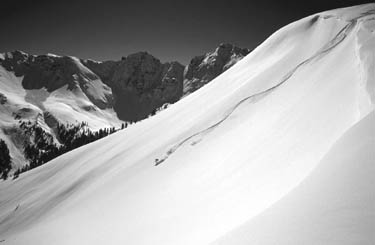|
Completion of the 'dream' to wait at least
another season
by Will Sands

Several years ago, Aaron Brill
first hatched his dream of an atypical ski area where the turns
would be steep, uncrowded and always fresh. He decided to deliberately
skirt the temptation of real estate and base the ski area purely
on skiing and lift ticket sales. He also wanted to make this ski
bum’s dream accessible to the ski bum and said he would
limit ticket prices to $25.
However, several years later,
Brill has realized only a portion of his dream, and Silverton
Mountain continues its uphill struggle. Most significantly, the
ski operation will be limited for the second year in its two-year
history to guided tours and $99 lift tickets as the Bureau of
Land Management begins the environmental impact statement it announced
would be necessary more than a year ago.
“It’s a slow process,
but at this point we’re in it and in the home stretch, so
I don’t really complain about it anymore,” said Brill.
A last-minute
surprise
Last season, the resort finally
opened for skiing Jan. 19. The opening had been delayed by the
construction of a recycled two-seat lift from California and the
inspection of the lift. Additionally, Brill’s plan for operations
had to be adjusted because of a decision by the BLM.
Brill owns 350 acres of old
mining claims on the 13,487-foot Storm Peak, roughly six miles
from Silverton. However, he has gone after a permit to allow skiing
on 1,300 adjacent acres of public land. Last fall, as Brill was
making the push toward opening day, the BLM decided a rigorous
environmental impact statement would be necessary prior to issuance
of the permit. At the time, Brill was disappointed.
“We are talking about
an area that has been heavily impacted by mining over the years,”
he said at the time. “We proposed no permanent structures
on public land. The lift is even on private land, so, the decision
definitely surprised us.”
Consequently, the resort was
limited to 20 guided tours per day. Brill said that this year
he had hoped to up the number of guided tours to 99 and drop the
ticket price while awaiting the findings of the EIS. “I
can pretty much say I’m not going to get 99,” he says.
“I’m about 99 percent sure that we’re going
to get 40 per day. But 40 is better than 20. And $99 is still
a steal compared to cat or heli skiing.”
Flaws in the
system?
With another year of guided
tours and the forthcoming EIS process in mind, Brill blamed a
flawed review process.
“The (review) system is
pretty much broken,” he said. “It’s exactly
the same whether you’re Silverton, Hesperus or Vail. Still,
we’re doing everything we can to be ready for next winter
on all fronts.”
In the meantime, the BLM has
handed responsibility for the EIS to Cirrus Ecological Solutions,
of Logan, Utah. The environmental consulting company has worked
extensively on ski area expansions, including Snowbird and the
recent Telluride expansion, as well as heli-skiing permitting.
Neil Artz, Cirrus’ team project manager, said that with
Silverton Mountain the biggest potential issue is skier safety.
“All of the prospective
alternative actions are driven by different ways to address the
primary concern, and that’s skier safety with respect to
the unstable snowpack,” he said. “That’s really
the driving issue.”
Artz said that a group of snow-safety
experts are reviewing the results of a five-year study conducted
by Brill. The BLM will eventually choose what it deems the best
alternative based on Cirrus’ findings and public input.
“The alternatives we’re
looking at are addressing different ways to balance the guided
and unguided programs,” Artz said.
Brill said he favors the proposed
action, which is unguided skiing.
Artz added that another area
the EIS will address is other backcountry travelers using the
public land and impacts of the ski area upon them.
“Another consideration
is safety of other backcountry tourers that are not resort guests
and may wish to use the permit area or areas outside the permit,”
he said.
(continued...)
|

